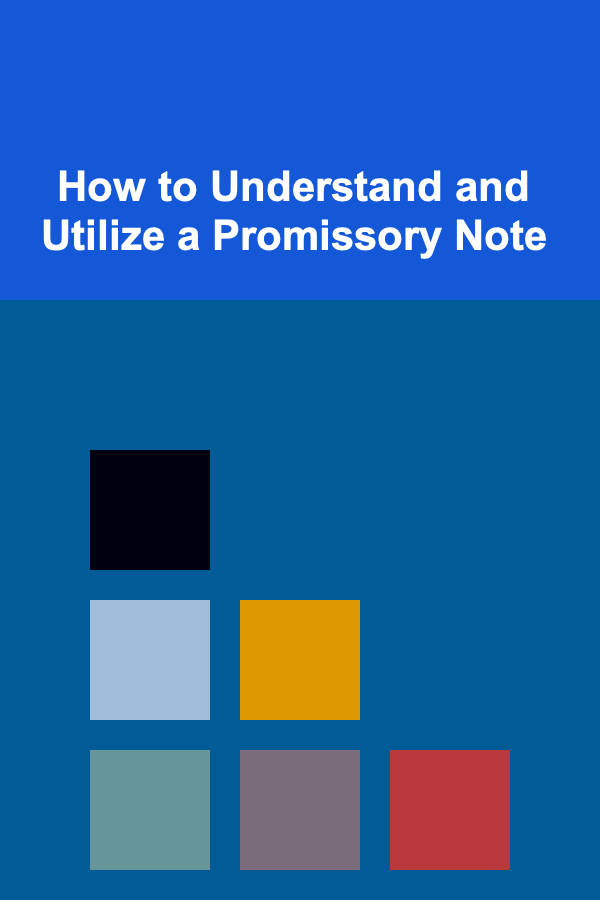
How to Understand and Utilize a Promissory Note
ebook include PDF & Audio bundle (Micro Guide)
$12.99$8.99
Limited Time Offer! Order within the next:

A promissory note is a simple yet essential financial instrument that has been used for centuries to formalize loans and debts. In this article, we will explore the nuances of a promissory note, how it functions, and how individuals and businesses can effectively use it. Whether you're looking to use a promissory note for a personal loan, a business transaction, or an investment, understanding its legal implications and practical applications is crucial.
What is a Promissory Note?
A promissory note is a written, legally binding document that outlines the terms of a loan or debt. It involves two parties: the borrower (the party who owes the debt) and the lender (the party to whom the debt is owed). The promissory note specifies the amount borrowed, the interest rate, the repayment schedule, and other critical details related to the loan.
At its core, a promissory note represents a promise to pay back the borrowed amount under agreed-upon terms. Unlike more complex loan agreements, promissory notes are generally simpler, focusing on the basic details of the debt. However, they are still enforceable in court if necessary.
Key Elements of a Promissory Note
While the specifics can vary depending on the situation, there are several common elements that should be included in a promissory note:
1. Principal Amount
This refers to the amount of money that the borrower is borrowing. The principal amount should be clearly stated in both numerals and words to avoid any ambiguity.
2. Interest Rate
A promissory note often includes an interest rate that the borrower will pay on the borrowed amount. This rate can be fixed or variable, depending on the agreement between the parties involved. Interest may be calculated annually, semi-annually, or according to a different timeframe.
3. Repayment Terms
This section outlines the schedule for repaying the loan. It specifies the frequency of payments (e.g., monthly, quarterly) and the due dates. The terms may also outline whether the borrower can make early repayments or whether any penalties apply for missed payments.
4. Maturity Date
The maturity date is the date by which the borrower must repay the entire loan amount. This may include both the principal and interest.
5. Collateral (if applicable)
If the loan is secured with collateral, this will be detailed in the promissory note. The collateral serves as a guarantee for the loan and provides the lender with a way to recover the debt if the borrower defaults.
6. Late Payment Penalties
Some promissory notes include clauses that specify the penalties the borrower will incur if they fail to make timely payments. These penalties could include late fees or increased interest rates.
7. Default Clauses
These clauses specify what happens if the borrower defaults on the loan, including potential legal action or other remedies the lender can pursue to recover the money.
8. Signatures
Both the borrower and the lender must sign the promissory note to make it legally binding. Witnesses may also be required in some jurisdictions, depending on the value of the loan or the nature of the agreement.
Types of Promissory Notes
Promissory notes can take different forms depending on the nature of the transaction. Here are some common types:
1. Unsecured Promissory Notes
These notes are not backed by any collateral, meaning that if the borrower defaults, the lender has no specific assets to claim. Unsecured promissory notes are typically used for personal loans or loans between friends and family. They carry a higher risk for lenders and may come with higher interest rates as a result.
2. Secured Promissory Notes
Secured promissory notes are backed by collateral, such as property, assets, or business equipment. In the event of a default, the lender can seize the collateral to recover the loan amount. Secured promissory notes are often used in business loans or mortgage agreements.
3. Demand Promissory Notes
A demand promissory note does not have a specific repayment date. Instead, the lender can demand repayment at any time, provided they give reasonable notice. These types of notes are more flexible but can create uncertainty for borrowers.
4. Installment Promissory Notes
These notes require the borrower to repay the loan in regular installments, typically on a monthly or quarterly basis. Each installment may include both principal and interest, and the schedule is often detailed in the promissory note.
5. Balloon Promissory Notes
A balloon promissory note includes lower periodic payments with a large final payment (the balloon payment) due at the end of the loan term. This structure is often used for short-term loans or when the borrower expects to have the funds to make the large final payment at the end of the term.
6. Convertible Promissory Notes
Convertible promissory notes are often used in investment scenarios, especially for startup funding. These notes allow the lender to convert the debt into equity in the borrowing entity at a later stage, usually during a subsequent funding round.
How to Use a Promissory Note
Promissory notes can be used in a variety of scenarios, from personal loans between friends to business financing. Below are several practical applications of promissory notes.
1. Personal Loans Between Friends or Family
One of the most common uses of a promissory note is for personal loans between friends or family members. While these loans are often informal, a written agreement can help avoid misunderstandings and provide both parties with clear terms. This can help preserve relationships by ensuring that everyone knows what to expect.
2. Business Loans
Small businesses often use promissory notes to formalize loans from family members, friends, or even private investors. A promissory note ensures that both parties have a clear understanding of the loan terms, which can help prevent legal disputes in the future.
3. Real Estate Transactions
In real estate, promissory notes are often used in conjunction with mortgages. The promissory note is signed by the borrower and outlines the repayment terms, while the mortgage deed secures the loan against the property.
4. Student Loans
Promissory notes are also used for student loans. Students sign a promissory note to agree to the terms of the loan, including the amount borrowed, interest rates, and repayment schedules. These notes are typically formalized through a government or private lender.
5. Investment and Funding
Promissory notes are often used in investment situations where a lender provides funds to a business in exchange for a promise of repayment. Convertible promissory notes, in particular, are popular in startup funding, as they allow the lender to convert the loan into equity in the company at a later stage.
Legal Considerations
While promissory notes are relatively simple financial documents, they are legally binding and should be treated with the same seriousness as other contracts. Here are some legal considerations to keep in mind:
1. Enforceability
For a promissory note to be enforceable, it must meet certain legal requirements. This typically includes clear identification of both parties, a definite amount, a repayment schedule, and signatures from both parties. In some jurisdictions, additional requirements, such as witnesses or notarization, may be needed.
2. Jurisdiction and Governing Law
A promissory note should specify which laws govern the agreement. This is particularly important if the parties are in different locations, as it can determine which state or country's laws will apply in the event of a dispute.
3. Default and Remedies
If the borrower defaults on the promissory note, the lender has the legal right to take certain actions to recover the debt. These actions may include legal proceedings or the seizure of collateral (in the case of a secured note). The note should clearly outline what constitutes default and the lender's remedies.
Benefits of Using a Promissory Note
There are several advantages to using a promissory note for loans and financial transactions:
1. Clarity and Legal Protection
A promissory note provides both the borrower and lender with clear terms and conditions. This clarity can help prevent misunderstandings and ensure that both parties know what is expected.
2. Flexibility
Promissory notes can be tailored to fit a wide range of financial arrangements, from simple loans to complex business agreements. The terms can be adjusted to meet the needs of both parties.
3. Legally Enforceable
A properly drafted promissory note is legally binding, providing both parties with protection in case of default. If a borrower fails to repay the loan, the lender can take legal action to recover the debt.
4. Simple and Cost-Effective
Compared to more complex loan agreements, promissory notes are relatively simple to draft and execute. This makes them a cost-effective option for personal loans or small business financing.
Conclusion
Understanding and utilizing a promissory note can help both borrowers and lenders navigate financial transactions more effectively. Whether you're entering into a loan with a friend, securing business financing, or participating in a real estate deal, a promissory note provides a straightforward and legally binding way to formalize the agreement. By carefully considering the terms and ensuring that the note is properly executed, both parties can safeguard their interests and prevent misunderstandings down the road.
Reading More From Our Other Websites
- [Organization Tip 101] How to Plan for Future Hobby Projects with Organization
- [Survival Kit 101] Why Every Household Needs a First Aid Kit and How to Organize It
- [Personal Investment 101] How to Profit from Deep Learning by Creating AI Tools for Businesses
- [Personal Financial Planning 101] How to Financially Plan for a Career Change
- [Home Soundproofing 101] How to Soundproof Your Ceiling for Less Upstairs Noise
- [Home Budget 101] How to Pay Off Debt on a Budget: A Step-by-Step Guide for Financial Freedom
- [Paragliding Tip 101] From Takeoff to Landing: Secret Strategies to Increase Your Paragliding Flight Span
- [Organization Tip 101] How to Prep Your Deck for Staining with the Right Products
- [Personal Care Tips 101] How to Choose a Hair Mask for Dry and Brittle Hair
- [Personal Care Tips 101] How to Apply Sunscreen to Maximize Skin Health and Protection

How to Clean and Maintain Your Microwave
Read More
How to Decorate Your Home Rental Property to Attract Ideal Tenants
Read More
How to Maintain a Clean Family Room with Simple Habits
Read More
How to Make Money Online as a Vlogger on YouTube
Read More
The Ultimate Guide to Lowering Home Loan Interest Rates in Today's Market
Read More
How To Boost Your Cellular Health
Read MoreOther Products

How to Clean and Maintain Your Microwave
Read More
How to Decorate Your Home Rental Property to Attract Ideal Tenants
Read More
How to Maintain a Clean Family Room with Simple Habits
Read More
How to Make Money Online as a Vlogger on YouTube
Read More
The Ultimate Guide to Lowering Home Loan Interest Rates in Today's Market
Read More